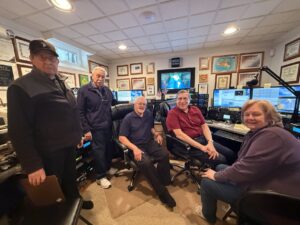BATTERY LIFE CALCULATORTo calculate battery life, use the formula:
Battery life (amp hours) = Battery Capacity (amp-hours)
Current Draw (amps)
Battery life (amp hours) = 2.6 (amp-hours) / 0.135 (amps)
Given your battery’s capacity of 2.6 amp-hours and a current draw in the receive mode of 0.135 amps (135 mA), you can plug these values into the formula:
Battery Life (hours) = Battery Capacity / Battery Draw
Battery Life (hours) = 2.6 Amp-Hours / 0.135 Amps
Battery Life (hours) = 2.6 / 0.135
Battery Life (hours) = 19.26
With a 135mA current draw in receive mode, your battery will last approximately 19.26 hours.
For Example:
Elecraft KX2 Current Draw in Transmit Mode
The KX2’s current consumption during transmission varies based on factors like output power, operating mode (CW, SSB, DIG), and connected accessories.
At 5 Watts Output Power (Typical QRP Operation):
• CW Mode: Draws around 0.8 to 1.0 amps. Considering a 25% duty cycle, the effective average current is approximately 0.20 to 0.25 amps.
• SSB Mode: Draws around 1.5 to 2.0 amps. With a 30% duty cycle, the average current falls between 0.50 to 0.70 amps.
• DIG Mode: Draws around 1.5 to 2.0 amps. Given a 65% duty cycle, the average current ranges from 0.98 to 1.3 amps.
________________________________________
At 10 Watts Output Power (Higher Power Operation):
• CW Mode: Draws around 1.5 to 2.5 amps. With a 25% duty cycle, the average current is approximately 0.38 to 0.63 amps.
• SSB Mode: Draws around 2.5 to 3.5 amps. Considering a 30% duty cycle, this results in an average current of 0.75 to 1.05 amps.
• DIG Mode: Draws around 2.5 to 3.5 amps. Due to a 65% duty cycle, the average current is roughly 1.6 to 2.3 amps.
________________________________________
Key Takeaways:
• Higher output power increases current draw proportionally.
• Digital modes (DIG) have the highest duty cycle, leading to greater average current consumption.
• CW and SSB modes, due to lower duty cycles, are more battery-efficient, especially at QRP levels.
Understanding these current draws and duty cycles can help you optimize battery life for portable operations.
DUTY CYCLES – CW vs SSB vs DIG
The duty cycle of a transmitter refers to the percentage of time it actively transmits RF energy during operation. This varies significantly depending on the mode of transmission—CW, SSB, or digital.
CW (Morse Code) Transmitters
For CW transmitters, the duty cycle during active transmission typically ranges from 10% to 30%. This is because Morse code involves alternating between brief periods of transmission (the dots and dashes) and silence (the spaces between characters and words).
For example, if you’re sending Morse code at a moderate speed of around 12 words per minute, with evenly spaced characters and words, the transmitter might be active for 1 to 3 seconds out of every 10 seconds. This results in an estimated duty cycle of roughly 10% to 30%.
However, this is only an approximation. The actual duty cycle can vary based on several factors:
• The specific Morse code being sent (longer dashes vs. shorter dots).
• The operator’s sending speed and technique.
• Pauses or breaks between transmissions.
________________________________________
SSB (Single Sideband) Transmitters
For SSB voice transmissions, the duty cycle is generally higher than CW but still relatively low compared to modes like FM or AM. This is because SSB transmits only when there’s audio input—primarily during speech.
The duty cycle for SSB typically falls between 20% and 40% during active voice transmission. This means that while conversing, the transmitter is active for part of the time when the operator is speaking, interspersed with silent periods between words, sentences, or pauses in conversation.
Factors influencing the SSB duty cycle include:
• Speaking rate and style (fast talkers vs. slow, deliberate speakers).
• The frequency and length of pauses.
• The nature of the conversation (continuous speech vs. short exchanges).
For digital modes over SSB (like FT8), the duty cycle can be much higher because data signals are more continuous compared to the sporadic nature of human speech.
________________________________________
Digital Mode Transmitters
Digital modes exhibit the widest range of duty cycles, depending on the specific mode and the data transmission pattern.
• High-Duty Cycle Modes: Modes like PSK31, FT8, and JT65 involve continuous data transmission in structured bursts, often with very minimal breaks. The duty cycle in these modes can approach 100%, meaning the transmitter is active almost the entire time during data exchange.
• Lower-Duty Cycle Modes: In contrast, modes like Packet Radio (AX.25) or APRS transmit data in discrete packets with intermittent breaks. The duty cycle in these cases is lower and varies based on:
o Packet size and frequency.
o Network activity and traffic load.
o Transmission settings and protocols.
________________________________________
Summary
• CW: 10% to 30% (depends on sending speed and style).
• SSB: 20% to 40% (varies with speech patterns and pauses).
• Digital Modes: Varies widely—from near 100% (FT8, PSK31) to much lower (Packet Radio, APRS).
Understanding these duty cycles is crucial, especially when considering transmitter cooling, power output settings, and overall equipment longevity.








